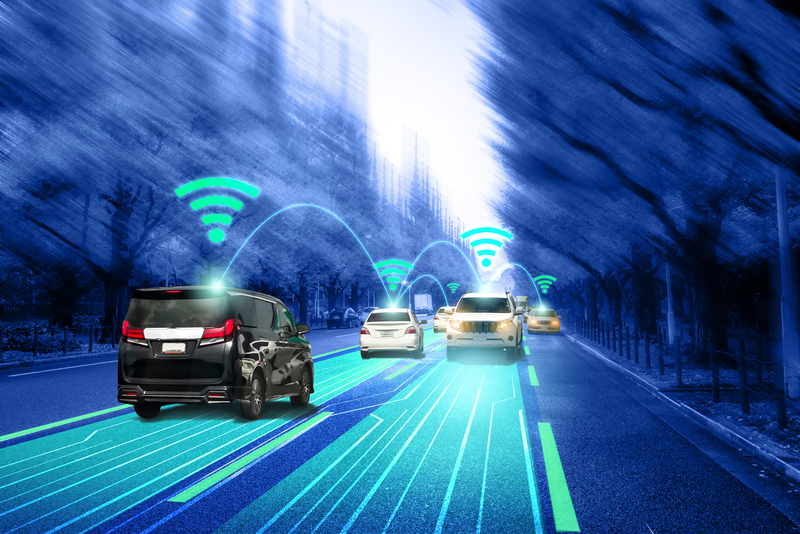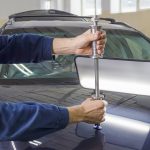Picture this: You’re parked at the grocery store when golf ball-sized hail begins pelting your car. Twenty minutes later, you walk out to find an array of dents across your hood and what looks like a spider web crack in your windshield. Your first thought? “Great, there goes my weekend dealing with insurance.”
But here’s what most people don’t realize…that seemingly minor windshield crack might have just compromised the very technology designed to save your life.
Today’s vehicles aren’t just metal and glass anymore. They’re rolling computers packed with Advanced Driver Assistance Systems (ADAS)—a network of cameras, sensors, and software that actively work to prevent accidents. The problem? These same safety systems can be quietly compromised by something as simple as a hailstorm, even when the visible damage looks manageable.
The Hidden Technology Protecting You
Modern vehicles rely on an invisible safety net of ADAS features that most drivers barely notice—until they’re not working. These systems include:
- Forward collision warning and automatic emergency braking that can slam on the brakes when you don’t react fast enough
- Lane departure warning and lane keep assist that gently nudge you back between the lines
- Adaptive cruise control that maintains safe following distances automatically
- Blind spot monitoring that alerts you to vehicles lurking in your peripheral vision
- Parking sensors and rear cross-traffic alert that help you navigate tight spaces
- Automatic high beams and rain-sensing wipers that adjust to driving conditions
These features rely on a sophisticated combination of forward-facing cameras, radar sensors, ultrasonic sensors, and even lidar systems to detect obstacles and interpret your driving environment in real-time.
The numbers tell the story: Research from the Insurance Institute for Highway Safety (IIHS) shows that forward collision warning systems reduce rear-end crashes by 27%, while automatic emergency braking systems slash them by an impressive 50%. When these systems are working properly, they make a measurable difference in preventing accidents and saving lives.
How Hail Turns Safety Systems Into Silent Hazards
Even when your ADAS components appear untouched after a hailstorm, damage can lurk beneath the surface in several troubling ways:
Physical Misalignment: When Millimeters Matter
ADAS sensors are often located in the most vulnerable spots on your vehicle—behind bumpers, in grilles, and near side mirrors. Hail dents in these areas can shift sensor positions by just a few millimeters, but the consequences down the road are significant. Consider this: A radar sensor that’s misaligned by just one degree can miscalculate the distance to the vehicle ahead by several feet, drastically reducing the time your system has to react in an emergency.
Glass Damage: The Window to Danger
Many ADAS functions depend on cameras mounted behind your windshield. Even a chip that looks insignificant can distort the camera’s field of view. The result? Lane departure warnings might trigger when you’re driving perfectly straight, or worse—the system might miss a genuine hazard entirely.
According to AAA’s research on ADAS repair costs, windshield replacement on ADAS-equipped vehicles requires precise specifications. Many automakers now require Original Equipment Manufacturer (OEM) glass rather than aftermarket alternatives to ensure cameras function properly. Some car dealers will even refuse to calibrate a camera sensor on a vehicle with aftermarket glass installed.
Water Intrusion: The Silent Killer
Hail can damage seals around sensors, cameras, or headlight assemblies that house safety technology. Once moisture penetrates these components, electronics can corrode or short-circuit over time, leading to gradual system failures that might not become apparent until it’s too late.
Hidden Surface Damage
Unlike obvious dents in your hood, damage to sensor covers or housing can be nearly invisible without close inspection. This is why a quick visual check after a hailstorm can leave you with hidden safety vulnerabilities.
Why Calibration Is Critical After Any Repair
When sensors and cameras are moved—even slightly during repairs—your vehicle’s safety systems may still “think” they’re positioned correctly. Professional calibration addresses this disconnect through two methods:
Static Calibration: Performed in a controlled shop environment using specialized equipment and targets to ensure cameras and sensors are correctly aligned before your vehicle returns to the road.
Dynamic Calibration: Conducted while driving the vehicle at specific speeds under controlled conditions so sensors can relearn their environment.
The calibration process isn’t cheap, but it’s essential. Recent industry data shows ADAS calibration costs average $350-500 per system, and AAA research reveals that ADAS components can add up to 37.6% to total repair costs. However, the alternative—driving with compromised safety systems—puts you and others at serious risk.
Real-World Consequences: When ADAS Goes Wrong
The National Highway Traffic Safety Administration (NHTSA) has documented several concerning patterns in their crash reporting database for ADAS-equipped vehicles:
- Lane departure warning misfires: The system signals you’re drifting when you’re perfectly centered in your lane
- Adaptive cruise control overreactions: The car suddenly brakes for phantom objects or fails to slow down when it should
- Blind spot monitoring failures: Warning lights don’t activate when another vehicle is actually present
- Parking sensor malfunctions: Complete failure to detect obstacles, increasing backing accidents
One particularly telling case involves a 2010 Honda Fit that had its roof panel replaced in 2012 after hail damage. According to automotive industry experts, when this vehicle was later involved in an accident, investigators discovered that the windshield-mounted camera had never been properly calibrated after the roof replacement. A simple calibration procedure could have prevented what became a much more serious situation.
Your Action Plan After a Hailstorm
1. Conduct a Thorough Inspection
Don’t limit yourself to obvious damage on the roof and hood. Systematically check:
- Windshield and side glass for any chips, cracks, or pitting
- Bumpers, grilles, and mirrors for dents or displacement
- Known camera and sensor locations for visible damage
- The area around your rearview mirror where cameras are often mounted
2. Watch for Dashboard Warnings
Modern vehicles typically display warning lights or messages when safety systems malfunction. Don’t ignore these alerts—they’re your first indication that ADAS calibration may be needed.
3. Document Everything
Take clear, detailed photos of all visible damage for insurance purposes. This documentation speeds up claim processing and helps ensure proper repair scheduling.
4. Schedule Professional Assessment
Even if you don’t see obvious ADAS damage, have a certified technician evaluate your vehicle. Industry research indicates that many necessary ADAS calibrations are overlooked when shops lack specialized training or equipment, which is why it’s important to work with facilities experienced in these systems. Specialized diagnostic tools can detect misalignments that are invisible to the naked eye.
5. Address Glass Damage Immediately
Small chips can spread rapidly, especially in temperature fluctuations. The longer you wait, the more likely you’ll need complete replacement—and additional calibration procedures.
The Bigger Picture: Safety Beyond Cosmetics
Modern vehicle repair isn’t just about making your car look good again—it’s about ensuring the integrated safety systems that protect you and your family continue to function as designed. Research from the AAA Foundation for Traffic Safety projects that ADAS technologies could prevent nearly 250,000 deaths over the next 30 years, but only if these systems are properly maintained and calibrated.
A perfectly painted hood means little if your forward-facing radar is pointing several degrees off-center. A crystal-clear windshield won’t help if the camera behind it can’t properly interpret lane markings because of an overlooked crack.
The Human Element: Why This Matters to Real People
Consider Sarah, a working mother from Denver who survived Colorado’s devastating May 8, 2017 hailstorm, an event that caused $2.3 billion in damage and generated over 300,000 insurance claims. Her SUV looked fine after repairs, but six months later, her automatic emergency braking failed to engage when a child chased a ball into the street. Fortunately, Sarah’s quick reflexes prevented tragedy, but the near-miss led to the discovery that her vehicle’s front-facing camera had never been recalibrated after windshield replacement.
Stories like Sarah’s underscore why treating hail repair as a complete process—addressing cosmetic restoration, structural integrity, and safety system calibration—isn’t just good practice, it’s essential for protecting lives.
Looking Forward: The Growing Importance of ADAS
The prevalence of these systems is only increasing. Current data shows that over 90% of new vehicles now come equipped with at least one ADAS feature, making proper calibration an increasingly critical part of vehicle maintenance and repair.
As these technologies become more sophisticated and widespread, the consequences of neglecting proper calibration will only grow more severe. What might seem like an unnecessary expense today could mean the difference between a close call and a tragedy tomorrow.
The Bottom Line
Spring and summer hailstorms can cause more than cosmetic damage—they can quietly compromise the technology designed to keep you safe. Understanding the connection between hail damage and ADAS performance helps you make smarter repair decisions, protect your investment, and most importantly, safeguard everyone who rides in your vehicle.
The next time hail threatens your area, remember: it’s not just about fixing dents. It’s about ensuring that the invisible shield of safety technology surrounding your vehicle remains intact and ready to protect you when it matters most.
If your vehicle has been caught in a hailstorm, don’t stop at fixing the obvious damage. Make sure your safety systems are functioning as they should. For Texas residents, contact US Hail Repair to find a trusted local repair location that can restore both your vehicle’s appearance and the performance of its ADAS features. For drivers in other areas, seek out certified collision repair centers with ADAS calibration capabilities.



